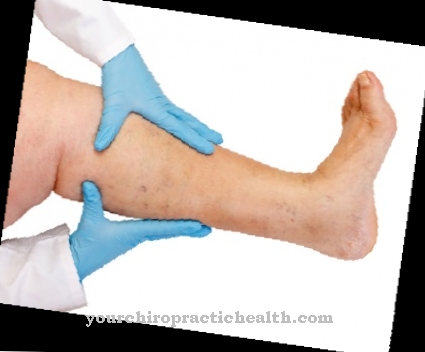Moles are very common on human skin. Most are benign and do not require medical treatment. In rare cases, liver spots can also become malignant and are then closely related to skin cancer. In the latter case, a dermatologist should of course be consulted at an early stage to remove these tumor-like moles. Birthmarks are a sub-form of moles.
What is mole?

Colloquially, a mole is a brown, flat birthmark that has formed through an accumulation of nevus cells in the epidermis and dermis. These nevus cells resemble pigment-forming cells (so-called melanocytes) and get their color from the skin pigment melanin.
Depending on the layer of skin in which the cells have accumulated, a distinction is made between different "nevus cell nevi": This creates a junction nevus in the border zone between epidermis and dermis. As a rule, this smooth mole, which is evenly brown to brown-black in color, is innate and begins to stand out in adolescence.
A compound nevus, on the other hand, is located in the upper area of the dermis and usually manifests itself in puberty as a raised, sometimes nodular, brown-black skin change. But liver spots can also form in adulthood. These dermal nevi are mostly knotty, light brown and characterized by increased hair growth.
causes
Moles develop in almost everyone. In the case of congenital birthmarks, it is currently assumed that there is a familial disposition. The nevus cells multiply already in the womb and form a mole in the upper layer of the skin or initially rest there in order to then develop in the course of life.
There are a number of factors that promote the later growth of moles.For example, strong exposure to light and UV radiation promote the formation of such skin tumors. Therefore, more moles can be found on the body of people who regularly go to the tanning salon. Light-skinned people in particular develop more pigment deposits on areas of the skin that are exposed to the sun.
But hormonal changes, such as those that occur during puberty or pregnancy, also affect the growth of liver spots. Such skin changes can increasingly be found after chemotherapy. It is therefore believed that a weakened immune system also supports the formation of moles.
Diseases with this symptom
- Skin cancer
- Melanoma
- Age spots
Complications

Depending on the type of mole, the skin changes either do not cause any complications or pose significant health risks. Benign moles are only an aesthetic flaw and do not cause any problems without treatment. However, it is possible that the patient accidentally injures the mole and then changes it, for example in the case of a fibroma.
Raised liver spots of this kind are annoying when putting on or drying off, for example. A removal of benign moles usually goes without serious complications. Sometimes there is temporary skin irritation or pain. The wound site rarely becomes inflamed. Sometimes, however, moles are caused by malignant diseases such as black skin cancer.
Without treatment, the cancer may metastasize in the body and thus pose a serious threat to the patient's life. Because the distant metastases displace healthy tissue and affect internal organs, so that their function declines and in the end stage may fail completely. But even with the treatment of malignant moles there are sometimes complications.
On the one hand, recurrences are possible, on the other hand, the general state of health worsens in some patients due to the surgical interventions and possible radiation. The sore areas can become inflamed or heal poorly, especially if larger areas of skin are affected or the patient is older. The irritation makes the skin more susceptible to infections and fungal infections.
When should you go to the doctor?
At first glance, a mole is not a worrying symptom. Nevertheless, caution is required in such a case if the person concerned notices that the mole is changing in shape, color or texture. If a mole remains without any changes for several years, then of course no doctor needs to be consulted. However, a visit to the doctor is absolutely necessary for the first changes. A dermatologist is the right contact in such a case.
Serious underlying diseases can only be excluded or identified and treated with an early visit to the doctor. A dermatologist can see directly with his trained eye whether the present mole is a danger or not. For this reason, a visit to the doctor should not be put off the back burner. In the worst case, a malignant tumor can be hidden behind a mole. Skin cancer is a very aggressive form of cancer that metastasize the body within a very short time. Early diagnosis and treatment are therefore extremely important to ensure a full recovery.
Doctors & therapists in your area
Treatment & Therapy
Moles are in most cases benign skin changes and therefore do not require treatment from a health or medical point of view. People who find moles annoying for cosmetic and aesthetic reasons can have them completely and permanently removed with a small surgical procedure. The costs of such treatment are only covered by the health insurance if there is a medical need; i.e. so only if the mole is malignant.
Annoying moles can also be burned out with a laser treatment. But be careful: If you are planning such an operation, you should have an experienced dermatologist certify in advance that the mole to be removed is benign. If this is not the case, the laser beams can cause the tissue of the malignant skin lesion to become more dangerous.
Another way to have moles removed is through freezing. However, since this variant is still very young and has not yet shown particularly good success, it is currently not recommended.
Outlook & forecast
A mole is a benign skin lesion that usually doesn't require treatment. Even without any treatment, a mole is completely harmless and does not cause any discomfort or pain.
However, this is different if the mole changes its shape or color. If a mole turns out to be malignant or if skin cancer is diagnosed, a doctor should of course be consulted. If you do not seek medical treatment, the prognosis is anything but good. Skin cancer is considered to be a very aggressive type of cancer that requires professional treatment. The patient's life depends on it.
An important factor in diagnosing "skin cancer" is time. The earlier the skin cancer is detected, the better the chances of a full recovery and healing. Therefore, it is extremely important that a doctor be consulted for any changes in a mole. Only then can appropriate treatment be given. It is important that the cancer has not yet spread in the body. Because of this, a mole needs to be kept under constant surveillance.
prevention
Since moles are partly a matter of predisposition, they can only be prevented partially and to a limited extent. But especially people with fair skin type should only enjoy sunbathing in moderation and always pay attention to sufficient sun protection. Because sunburns increase the development of melanomas enormously. Furthermore, as part of cancer prevention, everyone should have their moles checked regularly by a dermatologist.
Statutory health insurance companies undertake a standardized early detection examination for skin cancer for patients aged 35 and over every two years. In addition, each individual should also observe their moles themselves and pay attention to any noticeable changes and altered symptoms such as itching or oozing and consult a dermatologist independently if they suspect.
You can do that yourself
In most cases, there is no need for treatment or self-help for the mole. The mole is not a particularly dangerous condition for the body and therefore does not need to be treated if it does not change.
Almost everyone has moles on their body. The person concerned should always pay attention to whether the mole changes. If it does, it could be melanoma. In this case, the mole needs to be removed by a doctor before it spreads to other regions of the body. A mole can change in size, shape, and color. If these changes occur, a doctor must be consulted immediately. Home treatment is not possible in this case, as the doctor will have to remove the mole. The removal is pain-free and does not lead to further complications or problems. In general, people with many moles should use adequate sun protection and not expose themselves to the sun for more than 20 minutes without protection.
A doctor should also be seen if the mole hurts or feels uncomfortable. Often dark hairs grow out of a mole and look unattractive. These can be plucked out, but in most cases they will grow back.
























.jpg)



